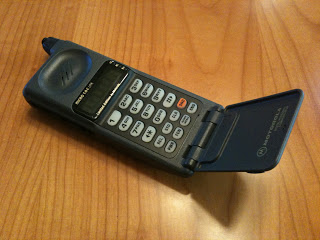The Decline and Fall of the Cell Phone
December 3, 2013
(Another post from the Wayback machine, found stuck in the blogpost “drafts” - this from two years ago, around this time of year.)
My daughter was cleaning out some of her old toys and stuff (in anticipation, I guess, of the forthcoming Christmas arrival of new toys and stuff) and decided it was time to part with this.

I gave her this old phone a few years ago; it had been sitting in my parts bin, and I thought it would make a great “play phone” – and it did, until this year it was outgrown and replaced with a desire for a real cell phone (no, Santa’s definitely not bringing a nine-year-old a cell phone for Christmas…)
Looking at the phone, which represented the state-of-the-art when I bought it back in the early 1990s, I found myself musing on what had happened to cell phones since then.
This “Micro T.A.C. Lite Digital Personal Communicator” was the first of the “small” phones - small enough to stuff in a jeans pocket, or in a purse. It was the lightest cell phone ever, at 7.7 oz. Prior to this, cell phones were twice the size. It looks big now, but this phone represented a huge leap forward. The battery life was OK, but the phone was truly portable, and broke new ground.
It was also tough, in a nearly-unbreakable way. My phone wasn’t treated with kid gloves, and it still looks pretty much like new.
And, it was a good phone. It worked well. It felt good - the materials had a feeling of quality, it sat nicely in the hand, the distance from earpiece to the end was sized to match the human head. It was the cellular, mobile analog of the classic Ma Bell desktop phone, ubiquitous across America for a couple of generations.
All of these things can also be said of the next phone I bought, also from Motorola - the Star TAC. It, too, represented a big leap forward (or downward?) in size and weight, and was still convenient to use in the hand; somehow, Motorola kept the toughness of the Micro TAC, for the Star TAC felt equally indestructible.
These phones were from the time when phones were just phones - they were expected to do one thing well, and (mostly) they did, and kept doing it better over time. They got smaller, their batteries lasted longer, but the basic functionality (it’s a phone!) stayed the same.
Eventually, though, two things happened: consumers wanted (or, perhaps, technology companies decided to sell to consumers) ever-smaller devices, and phones took on more and more functionality. The very simple phonebook feature of these early Motorolas led to addressbooks, simple games, a calculator, text-messaging… a slippery slope. Soon enough, the fairly short list of features that made a truly great phone (robustness, a bright, clear display, good audio quality, long battery life, and a nice feel in the hand) was almost entirely pushed aside in preference to miniaturization, sleekness, size and color and quantity of the display(s), and number of secondary functions the device could perform (games, music player, calendar, to-do list, etc.)
I think we are, in some cases, starting to drift back towards good functionality of cell phones as phones. But Motorola and Nokia, once the dominant designers and manufacturers of truly good phones, seem to have fallen by the wayside, casualties of the market’s whims. I don’t hear consumers clamoring for fewer features in their phones, but perhaps a bit of recognition that the absolute sleekest, thinnest, most-stylish phone is not necessarily the most useful phone…
Anna says, this is the same thing that happened to toaster ovens (and, I suspect, many many other appliances, and other consumer products.)